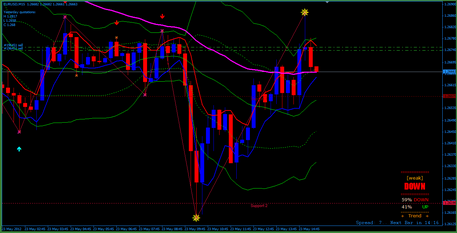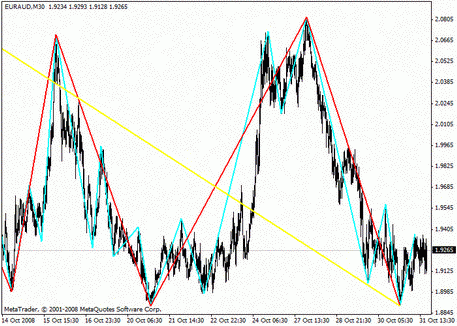
Alligator Indicator
Alligator indicator belongs to the group of trading robots of Bill Williams - a brilliant trader and author of the books "Trading Chaos” and “New Trading Dimensions." On a chart, the tool is represented by three lines of different colors - smoothed moving averages with a different period and a different offset for every line. After the books’ release, the instrument had been actively tested by the traders all over the world. Now it is available as a free download on the MTD website.
Starting to study this Forex trading indicator, you should understand that Bill Williams' strategy doesn't have the usual technical analysis methods. The author argued that excessive deepening in the market analysis isn't useful. It's much better to know how the stock exchange works and to understand the trade mechanisms from within. Therefore, the Alligator indicator is significantly different from other groups of trading robots.
What is the Alligator indicator?
Bill Williams was a supporter of studying the market through the particular phases (periods) identification. It is known that any trading platform, including Forex, is in a state of a trading range for about 80% of the time. At this time, no forecasts are made, because the price is in a chaotic movement and it's quite problematic to anticipate its further course. Then the market sets a trend - when the price has a clear direction. During this period, traders enter an active analysis phase, trade, open deals, and make a profit. Using indicators that work with the trend, you can accurately determine the favorable time to enter the market and control your trading.
In the latter case, the Alligator will filter out the periods of the lateral range, or the lack of a trend, and will give a signal when the new price trend starts. Thus, you can buy or sell the asset even before it's affected by the competition among buyers or sellers, as well as by the conditions of speculators. You can download the Alligator indicator for free on the MTDownloads website, and test it on your strategy.
The description of the Alligator trading indicator
Each one has a different period and a different offset. During the moving indicator construction, the indicator takes into account not closing prices, but median prices. Each of the lines on the graph has its own specific name, which their creator preferred himself:
- The blue line is called the "alligator's jaw". The period is 13 with a shift of 8 bars;
- The green line is called the "alligator's lip" and has a period of 5 with a shift of 2;
- The red line is called the "alligator's teeth" - it has a period of 8 and a shift of 5.

The "alligator's jaw" is always the longest one on the graph. You need to rely on it if you want to understand, what level the price will be established at, in the absence of the significant factors influence. That is when, for example, no central bank decides to sell or buy currency sharply, there will be no natural disasters or other unforeseen circumstances. Therefore, the blue line is called the "Balance Line." Carrying out the technical analysis, you should focus on the following:
- If the price jumps above the "alligator's jaw," then it will also move up shortly.
- If the price level falls under the blue line, then prepare for the fact that the price will continue to fall, and we can also predict the adverse market reaction to a certain event or series of events.
Concerning the "alligator's lip" and the "teeth" of the beast, you can make the same predictions. However, they display shorter lengths of time. Recall that the graph shows green and red lines.
Alligator line interpretation
Mr. Williams himself interpreted the algorithm of the indicator quite peculiarly, but there is a logic in this description. The author said that if the lines of the Alligator intertwine, then the beast is asleep, and the longer it continues, the hungrier it becomes. If we consider this in the technical analysis context, then the "interlacing" is connected with a narrow trading range.
The next step is a breakthrough. Bill Williams explained the punching of the range by the fact that, after sleep, the Alligator is hungry, and to be satisfied, he hunts for the price. It is where the border breakthrough takes place.
At the next stage, the moving averages converge again, because the beast is full and its activity subsides. Traders need to consider this period as a time of the new consolidation. Then you should close the positions and prepare for a new trend.
Features of the trading robot application
Alligator, like many trend robots, is a lagging indicator. In a dynamic currency market, it is necessary to work with it carefully, and it is desirable to combine it with the other methods of the technical analysis. Adhere to a proven strategy, don't risk large sums and open only profitable deals, without relying on the indicator entirely.
The indicator sends a signal to open the order when the moving averages are separated from each other. When the lines are together, or a short distance away - this indicates the range state. In the latter case, speculators shouldn't open the positions.
In his "The New Trading Dimensions" book, Mr. Williams suggested that, if the order is opened at the moment when the average fluctuations amplitude increases, the deal is likely to succeed. To accurately understand the magnitude of the balance lines discrepancy, it's recommended to use the Gator Oscillator trading robot - it can also be downloaded on the MTDownloads website.
Recommendations for the indicator use
Whichever trade robot you prefer, we don't recommend you to use the indicators alone, and the Alligator isn't the exception. If you use the technical analysis tools in combination, they will provide more accurate data, since any robot has errors in operation.
Bill Williams recommended combining the Alligator with AO and AC indicators, fractals, oscillators. His decision was based on the fact that the author considered a better entering signal as not the "push" of the Alligator, but a breakdown of the fractal above or below the moving average. Also, Mr. Williams insisted that it's necessary to place stop orders under the balance lines.

 English
English
 русский
русский



